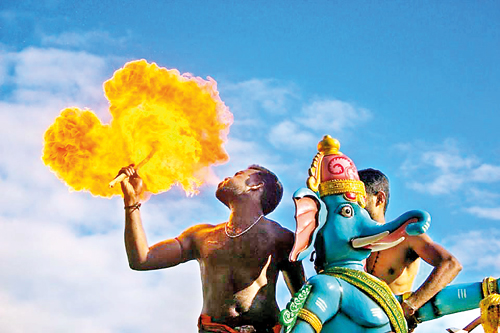The one that got away – Sandranathan Rubatheesan
The eldest son of a schoolteacher and a civil servant, in the peninsula village of Chavakachcheri, Sandranathan Rubatheesan found completing schooling difficult. Having already taken up photography as a hobby, when the war ended he felt he needed to get out of Jaffna: small place, densely populated, the usual and unusual conflicts. He came to Colombo – ‘like a different country’ – and in 2011 was accepted on a diploma course in journalism at Colombo University.
As a freelance journalist attached to the – ahem – Sunday Times, he would observe the staff photographers sent along with him on stories, and so decided to get into street photography, documenting the Colombo suburbs on his daily commute. His principal tool is a pocket-sized Fujifilm X10 camera, and he approaches his photography ‘as a mental process, not a mechanical one.’ Rubatheesan’s contribution to the recent Humanity & Earth exhibition at the Harold Peiris Gallery, he feels, constituted his debut as a photographer proper. He has several other long-term photographic projects still ongoing in the North (poverty, missing persons, the increased militarisation of the landscape). But he is now very aware that he may see even his home town from an outsider’s perspective.
He has also recently discovered an interest in farming, alongside his cousins and parents (now retired), with a particular focus on traditional, non-GM, varieties of paddy seeds.
The one that got away
‘I paid a high price for the shot I missed.
I’m not really a city kind of person, because I’m from a very rural background; so once or twice a month – or whenever Colombo life gets me down – I just take a train and go home: see my friends, go for drinks, bathe in the lagoon, stuff like that.
In 2017, I was on a very crowded train, so I was sitting in the doorway, on the footboard. Just before Anuradhapura the train stopped, waiting for a signal to change. It was mid afternoon, and there was a wide, green paddy field, and in the centre of it someone was burning off a plot of land, and there were a couple of peacocks flying low and slow, trying to get past the smoke. I’d never seen peacocks flying before. So I thought maybe I could make a good shot of that.
I picked up my camera, and started to zoom in, and suddenly the train started up again, and jerked. I wasn’t holding onto anything, because I was holding my camera – and I was thrown out of the train, and onto the opposite track. I got a broken elbow and a fractured wrist [he shows me two four-inch surgical scars] – but my camera was alright!
And then the train started moving. A couple of girls – from the UK, I think – were shouting “Stop the train! Stop the train!” but it didn’t, and so they had to pull me back on board by my other hand.
Somebody realised that I was a journalist, and I was surprised to see how people treated me. Someone offered me a 3rd-Class bench seat so I could lie down, and someone else gave me a cardboard file folder to hold my arm in. The girls gave me a painkiller, and kept talking to me, to make sure I didn’t go into shock.
I was in the Anuradhapura base hospital for seven days. The doctors asked if anyone had pushed me from the train, and the police asked if I’d tried to commit suicide. And I said, “No – I was just trying to take a picture!” Then they asked me if I regret doing that, and I said, “Well, it’s too late for that now.”
My friends made fun of me for that: risking my life to take a picture of some peacocks. But it’s just instinct, you know? Still, it was a good lesson for me, actually: no picture is worth my life.’
The shot that he got
‘This is a photo I made back at home, about 10 years ago, in Jaffna, during a Hindu religious festival.
It’s called ‘Soora Samhaaram’: the killing of the demons. The god Murugan comes out and defeats the demon Surapadman. The townspeople decorate the god and the demon – different faces, different outfits – and then it’s dramatised in public: good vs evil. Only good can win at the end, of course.
My parents are very religious people, and when I was a child they used to take me to this festival annually. I think I was always more interested in the demon, actually. They’re always the more interesting characters. And the performers sometimes use fire as a sign of how dangerous this demon is. So this is the bad guy, the asura, and the devotees are behind the statue, parading it around, and the guy behind has sucked up petrol in his mouth, and sprayed it.
When I made this image I didn’t realise how it would come out. But once I went home and uploaded it, it felt as though my subconscious mind had recreated it. And then when I saw it in print, it really struck me: this is what I felt when I was a kid. One of the earliest childhood memories I had, which I’ve now captured on film. And, as an adult, that angle is like I’ve kind of crept behind the scenes.’

‘The man behind the curtain’- by Sandranathan Rubatheesan


